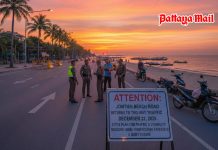Pattaya council still split over Makro U-turn, safety rollers
Pattaya garbage fees are set to double following new governmental regulations on the collection and transport of garbage and medical waste.
Speaking at the Pattaya City Council’s May 28 meeting, council President Banlue Kullavanijaya said the amount of garbage being produced in the city has increased to 300 tons per day, surging to up to 400 tons on holidays.

Pattaya long has used a private contractor to haul away its garbage and deal with eliminating sewage, but the price charged residents has not kept up with costs, he said.
Garbage fees currently were capped at 20 baht per residential household. Under the new regulation, the price would increase to a maximum 24 baht.
Sewage and infection waste fees are set to jump higher, however. Currently set at 20 baht, they would double to 40 baht under the government rule for a maximum 300 liters a day.
In other business, the council reviewed progress of a U-turn constructed, but never opened, in front of the Makro warehouse store in South Pattaya.
It was built last year with a million-baht budget after another turnabout 300 meters away was closed due to numerous accidents there. Originally opposed by the council, the turnaround remains closed due to lacking signage, signals and landscape alteration on the center median.
Officials as recently as February promised the U-turn would open “soon” but no progress has been made on hiring a contractor to make the required improvements.
Likewise, the council made no decision on how to handle the problems with safety-roller barriers installed on Pratamnak Road and the railway-parallel road in July.
In August, Councilman Sanit Boonmachai alleged corruption in the 10-million-baht project, claiming the orange bumpers were not installed correctly, did not improve road safety and only served to enrich those involved in the project.
Sanit claimed that safety rollers normally are installed on the sidewalk about 1.5-2 meters away from the edge of the footbath. But Pattaya installed them on the road’s surface resulting in narrow of traffic lanes, and placed them too far apart, creating the potential for injury if pedestrians tried to move between them.
The council at its meeting generally agreed repairs are needed, but failed to agree on when to carry them out or how to pay for them.




